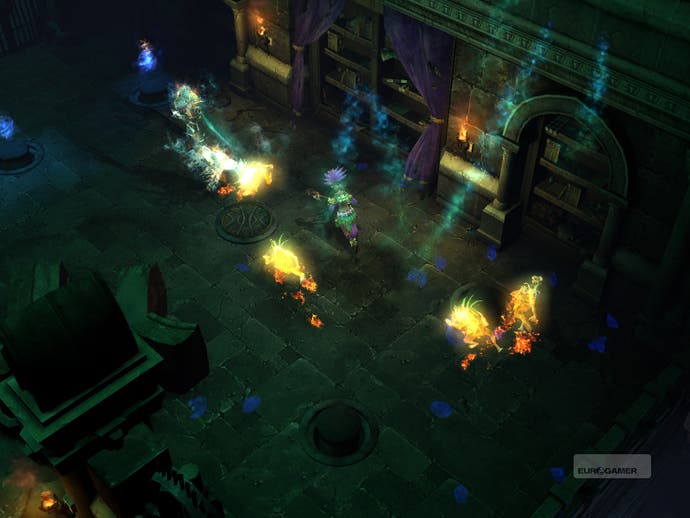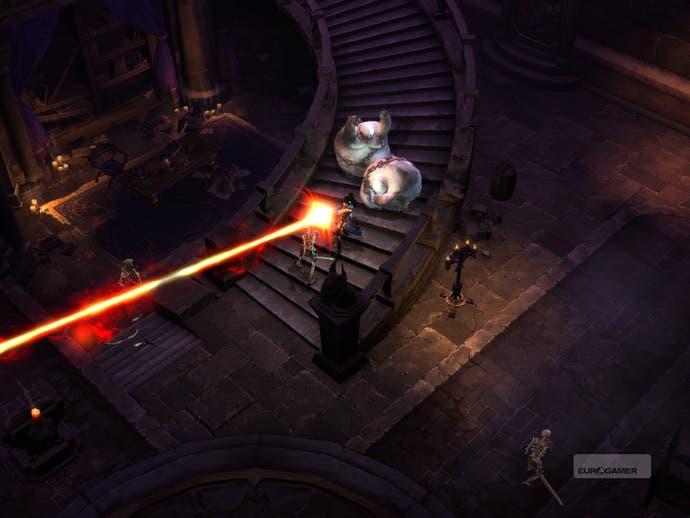Diablo III
A tale of four classes.
The Witch Doctor
Contrary to Wilson's expectations, I die quite a lot as the Witch Doctor, but that's because it takes me a little while to understand this highly unusual class. The spooky voodoo priest and zombie summoner is neither a classic ranged spellcaster nor even a traditional pet class; his attacks are indirect, but he still needs to get close to the action.
Wilson: "We like for the Witch Doctor to feel almost like he's a conductor in an orchestra. He's got all these things going, all these plates spinning, and that's the real challenge, keeping all those up... The Witch Doctor is: I'm going to set up my pets, I'm going to get all ready, then I'm going to walk them forward, and back off, and poison you and back and lob things in. Unlike the Necromancer [in Diablo II], where the pet was not only main line of defence but also primary damage, so you could kind of just look at your gear while your pets took care of everything. We designed him such that he can't stay too disengaged."
The Witch Doctor's pets - we get to play with Zombie Dogs at this level, a pair of sturdy undead hounds that distract enemies - are completely autonomous, but they hang close to their master. You need to dart dangerously close to deploy them, and perhaps unleash a scourge of poisonous spiders, before pulling back to hurl the glorious but inaccurate flaming skulls. It's almost like micro-managing an RTS raid, and positional play is hugely important. So's tempo; as with all the classes in Diablo III, once you start to feel the rhtythm and experiment with the interplay of skills, the random fracas slowly starts to gel into smooth crescendos of carnage, and demons fall like dominos. If dominos tended to blow up in fountains of gore, that is.

There are plenty of opportunities to conduct such symphonic violence in the demo. The quest asks you to follow a path across the desert to a devastated town, and if you do so without leaving it, you'll come across a handful of carefully paced and placed choke-points staffed with tougher demon mobs, punctuating more randomly-strewn cannon-fodder. There's a huge amount of freedom to wander off this beaten path, however, and either side-quests or simple curiosity can lead you into adventures just as long as the path from A to B. The map is scattered with portal entrances to randomised dungeons; escort an NPC to treasure, loot as much as you can before the edifice collapses in five minutes, or just harvest items and XP. Thickly populated with enemies and proudly showing off the extensive destructibility, these feel the most what you expected next-generation Diablo to be like.
The Wizard
Boyarsky: "The Wizard was kind of a child prodigy who comes from a very poor village... This Wizard is very young, she's the youngest of all the classes, she's probably like 19 or 20 years old, doesn't have a lot of experience but she is very very powerful, very talented at what she does, was probably a lot more powerful and smart than a lot of her instructors. She's basically a teenager with a lot of power. She has no religious leanings whatsoever, except she just wants to find out more about how she can wield more power. She could care less about what's actually going on."
Wilson: "The Wizard is really meant to be a classic glass cannon, but I think for me what really makes her interesting is that she's the person with a trick for everything. She's a complete and total master of magic, and so she uses that for everything, for survival, to impede enemies and to damage them as well. She can create illusionary copies of herself, she can turn her skin to stone, she can freeze her enemies in place and even has skills that can combine these ideas."

It was the Wizard, at the end of the day, that held me spellbound. Every one of these four classes is a unique and highly individual twist on classic RPG ideas; every one of them has a striking balance of thoughtful intricacy with that gluttonous, over-amplified sense of unbridled power that is what Diablo is all about. But none more so than the Wizard.
As Wilson says, the Wizard is a combination of full-bore magical fire-power with a cunning box of defensive tricks. At the level of the demo, she could pull and freeze enemies, slow them around her, distract them with illusions, bomb multiple distant targets with energy or cause devastating close-range damage to a single-target. Unlike most spellcasters, the Wizard isn't just about keeping enemies at a distance, but rather a constant ebb and flow of risk and reward, of cause and effect relative to range, with those health drops as the carrot, spurring you on, keeping you from being too conservative, keeping you on the tipping point.
It's thrilling stuff. In all four classes, even the meat-headed Barbarian, Diablo III is playing subtle games with the expected dynamics, without ever sacrificing the frantic forward momentum the series is famous for. In fact, it intensifies it. Maybe the classes only represent the basic building blocks of this game at present - but they already seem like a huge leap forward for the action RPG.








